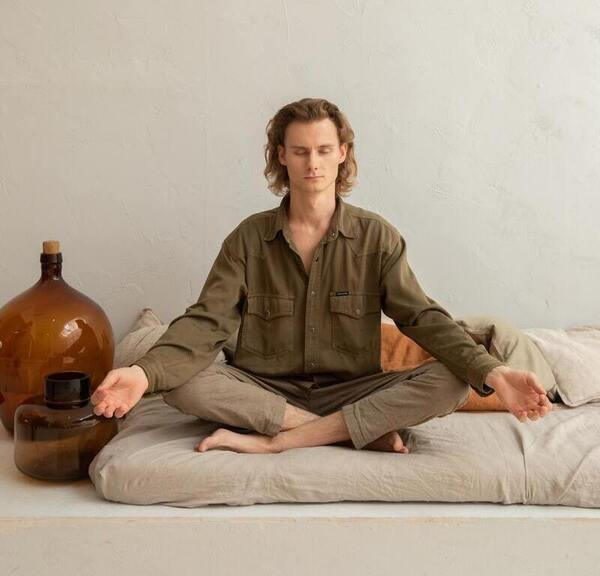This article looks at whether guided meditation is better for beginners. If you are thinking of getting started with meditation, you may find that guided meditation helps you find your way to exploring the benefits of meditation.
Who is Guided Meditation for?
Guided meditation is a mind-body therapy technique that trains the brain to work at a slower and more harmonious pace. Guided meditation is often practiced by stressed people with high blood pressure or risk factors for heart disease.
Meditation is one of the oldest techniques available for self-development, spiritual practice, and healing . The practice has been traced back through recordable history to various roots in ancient India, China, and Tibet.
Many have used meditation to train the mind, become more aware of the surroundings and environment around them, develop self-awareness and improve their mental clarity.
This form of self-development is often practiced for yoga, spiritual development, or to help relax and calm the body, mind, and emotions.
What is meditation?
Meditation is a way to get in touch with the deepest parts of yourself and to be present in the now. It is a time when you can find peace by allowing your thoughts and emotions to flow through you without being attached to them.

Meditation is about slowing the mind down to a point where it becomes quieter and calmer, allowing greater creativity and clearer thinking. This is because so much of our lives are based on our thoughts, beliefs, and ideas, on what we tell ourselves to be true.
Why learn to meditate?
- To release negativity: Meditation helps to create a space that allows negative thoughts and emotions to flow through you, out of your body.
- To learn how to relax: By practicing this regularly, you will learn how to relax your body and mind.
- To help with stress:
When stressed, we often neglect our bodies and minds and find it hard to relax. Meditation teaches the art of being mindful and relaxed.
- For a spiritual experience: Meditation is often used to free oneself from the physical form and embark on a journey of self-discovery.
- For healing pain:
Meditation is used as a way to deal with chronic pain; much the same way physical therapy can be used.
- To help with insomnia: Meditation can help to regulate sleep cycles and help to induce a restful night’s sleep.
- To deal with grief: Meditation is often used by those who have suffered a great loss as a way to cope with the emotions that follow such an event.
Making time to meditate
The first step to learning how to meditate is setting aside time to practice. Mediation can only be done later, as you could sit for 5 minutes and find yourself sitting for 30 minutes.
Meditation should be done in a peaceful, peaceful place that allows you to focus solely on your breathing. Cozy rooms will often do, but the key point is that your mind can only concentrate fully when no distractions are present.
A good rule of thumb is to allow 10-15 minutes of meditation each day, making sure to give yourself enough time, so you are not rushing or worrying about how long it’s taking.
Guided Meditation VS Silent Meditation: Which Is Right For You?
- Guided meditation is a form of traditional guided meditation given by someone else and involves you sitting for some time and allowing the guided meditation to take place.
- Silent meditation involves meditating on your own, rather than with another person.
- For those who are undertaking yoga or spiritual practices, guided meditations are often included in these sessions as they help to develop concentration, can help quiet the mind and promote a clearer outlook over the rest of the practice session.
Is one form of meditation better than another?
There are no set rules to help you decide which form of meditation is best for your needs. Some people swear by guided meditations and others by silent ones, but each has its advantages and disadvantages.
Some people prefer guided meditations because they feel it helps them concentrate better, while others prefer the quietness typical of silent ones.
Other than this, there isn’t a right or wrong way to practice meditation, as it depends on how you choose to use it.
Many popular meditation apps offer both guided and silent meditation. So what’s the difference, and which is right for you?
- Guided meditations involve you listening to the voice of a person or group and following their instructions.
- Silent meditations provide you with no form of assistance. The only sounds that may be present are that of the universe itself and your own breathing, making them much more intense.
- Guided meditation is more likely to produce positive results regarding stress, anxiety, and depression levels.
- Silent meditation is more effective in improving mental clarity, concentration, and creativity.
The benefits of guided meditation
- Guided meditations give you the space to be still and focus on your breathing, allowing you to learn how to calm your mind and feel peace of mind.
- Guided meditations are often included in various spiritual practices where they help you develop concentration, as well as by people who want a quiet meditation experience.
- Guided meditations can also help those who are learning about meditation for the first time.
- Guided meditations are often easier to learn and understand.
The benefits of silent meditation:
- It can be more intense than other forms of meditation and can create a more relaxed state, allowing you to achieve greater levels of mental clarity and concentration.
- By meditating in a silent setting, you can more easily hear your breathing and the sounds of your surroundings. The change in sound can help you to focus on your breathing rather than the rest of the world.
- Silent meditation can also activate the parasympathetic nervous system, which allows you to achieve a lower heart rate, lower blood pressure, and quicker recovery.
- Experiencing this form of meditation can lead to better overall health and wellness.
How to get started with Guided meditation
The first step to practicing guided meditation is to sit comfortably and close your eyes. The next step is to listen to the voice of the person who is leading you through the meditation process, making sure you are focused on your voice.
How to find a Guide
There are several ways you can find a guide to practice guided meditation with. You can search online, in the newspaper or in magazines. You can also look for a guided meditation at your local yoga studio; many health spas will offer them as part of their services.
Starting meditation
The first step to practicing meditation is finding a quiet place to sit quietly and not be distracted. The next step is to choose a time to practice meditation, ensuring you have at least 10 minutes in which you will not be disturbed.
This article looks at if guided meditation is better for beginners. Learning meditation skills is one of the important skills for self development. Find out about the other self development skills you can benefit from improving.






